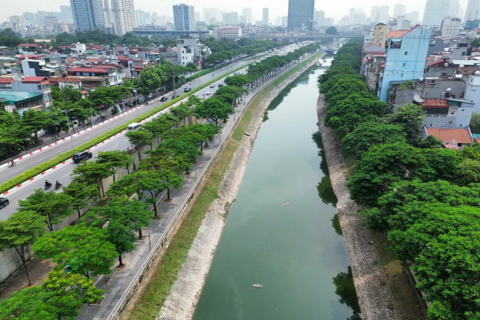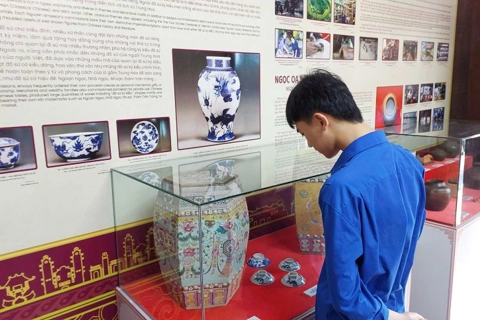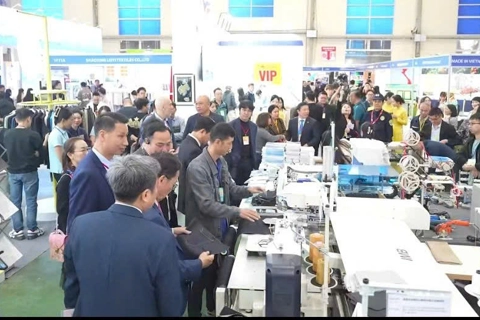Hanoi
Japan's bio-nanotechnology cleans water in Hanoi’s polluted river
Jun 01, 2019 / 07:31 PM
After seven days, sludge in the river’s floor began to decompose, reducing from more than one meter to about 76-91 cm, a clear layer of water appeared on the mud surface.
After seven days of treating water in Hanoi’s To Lich River with Japan’s nano-bioreactor technology, the river’s water quality has significantly improved, local media reported.
On May 31, half a month after Hanoi piloted nano-bioreactor technology in some sections of To Lich river, the river’s water gradually changed from black to milk-white and the bad smell of the river was partly disappearing.
Nguyen Van Thang, 60, who lives near the treated section, said: "In the past, my family often had to close the door the whole day because we could not bear the stench. Since the city installed Japan’s machines, bad smell of the river has reduced, we can even walk along the river bank in the afternoons".
Nguyen Tuan Anh, chairman of Nhat Viet Environmental Improvement Joint Stock Company, said that he received the results of To Lich river’s water quality twice, one after three days and the other after seven days piloting the nano-bioreactor technology in the river.
He cited that after three days, the stench of ammonia (NH3) decreased rapidly. After seven days, sludge in the river’s floor began to decompose, reducing from more than one meter of thickness to about 76-91 cm, a clear layer of water appeared above the mud.
"In the intermediate phase, the results help experts learn about changes of the water indicators, so we will not reveal more details. Scientifically, water indicators could only be obtained with accuracy after one or two months (of applying the technology). After two months, the amount of mud will be reduced, the river’s water will be cleaner. At that time, fish may swim on this section of the river," Tuan Anh said.
Japan's nano - bioreactor technology includes nanotechnology aeration using natural substances which the Japanese side has surveyed for two years before piloting it. The nano aeration system uses a specially-designed filter technology to extract air directly from the environment and then diffuse it into the water in the form of nano-sized air bubbles, according to Tuan Anh.
He added that the diffusion of nano-sized air bubbles in the water increases the dissolved oxygen content in the treated water area, including groundwater. As a result, aerobic microorganisms will be activated and natural metabolic processes will be nourished, the final nutrition chain will be improved. Recovering the nutrient chain will improve the water quality in a short time.
The quality water in To Lich river after treatment is measured independently by three units which are the General Department of Environment, the Institute of Environmental Technology under the Vietnam Academy of Science and Technology, and the Center for Quality and Protection of Water Resources. The results for the first phase of treatment are expected to be made public in late June.
On May 31, half a month after Hanoi piloted nano-bioreactor technology in some sections of To Lich river, the river’s water gradually changed from black to milk-white and the bad smell of the river was partly disappearing.
Nguyen Van Thang, 60, who lives near the treated section, said: "In the past, my family often had to close the door the whole day because we could not bear the stench. Since the city installed Japan’s machines, bad smell of the river has reduced, we can even walk along the river bank in the afternoons".

The section of To Lich River is treated with Japan’s technology on May 31. Photo: Tat Dinh
|
He cited that after three days, the stench of ammonia (NH3) decreased rapidly. After seven days, sludge in the river’s floor began to decompose, reducing from more than one meter of thickness to about 76-91 cm, a clear layer of water appeared above the mud.
"In the intermediate phase, the results help experts learn about changes of the water indicators, so we will not reveal more details. Scientifically, water indicators could only be obtained with accuracy after one or two months (of applying the technology). After two months, the amount of mud will be reduced, the river’s water will be cleaner. At that time, fish may swim on this section of the river," Tuan Anh said.
Japan's nano - bioreactor technology includes nanotechnology aeration using natural substances which the Japanese side has surveyed for two years before piloting it. The nano aeration system uses a specially-designed filter technology to extract air directly from the environment and then diffuse it into the water in the form of nano-sized air bubbles, according to Tuan Anh.
He added that the diffusion of nano-sized air bubbles in the water increases the dissolved oxygen content in the treated water area, including groundwater. As a result, aerobic microorganisms will be activated and natural metabolic processes will be nourished, the final nutrition chain will be improved. Recovering the nutrient chain will improve the water quality in a short time.
The quality water in To Lich river after treatment is measured independently by three units which are the General Department of Environment, the Institute of Environmental Technology under the Vietnam Academy of Science and Technology, and the Center for Quality and Protection of Water Resources. The results for the first phase of treatment are expected to be made public in late June.








